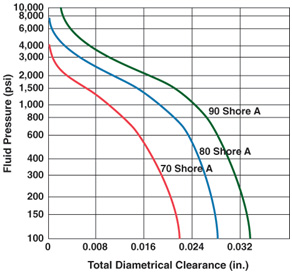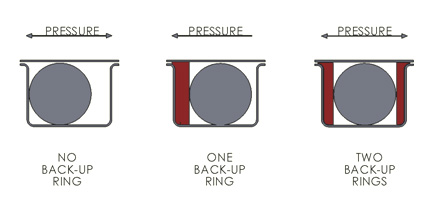When the pressure on an o-ring is increased to the point that it can no longer resist being extruded into the diametrical gap, and to compensate for loose fitting components, the use of backup rings to block the diametrical clearance gap and provide support for the o-ring may be a viable solution.
 A backup ring is made of a harder material than the o-ring itself, but sufficiently resilient to deform under pressure to close the extrusion gap. Backup rings are fitted into o-ring grooves that are dimensionally increased in size to accommodate the use of a backup ring or rings.
A backup ring is made of a harder material than the o-ring itself, but sufficiently resilient to deform under pressure to close the extrusion gap. Backup rings are fitted into o-ring grooves that are dimensionally increased in size to accommodate the use of a backup ring or rings.
A variety of materials may be used for backup rings including hard rubber, metal, and PTFE. PTFE has the advantage of offering very low friction for dynamic applications. The use of two backup rings in each groove, one on each side of the o-ring is recommended even though pressure is from only one side of the o-ring to prevent installation error. If only one backup ring is to be used it should be placed so that the o-ring is between it and the pressure. The main requirement of a backup ring is that it won’t collapse or cold flow.
Backup rings come in different configurations  from simple splits to solid rings which can be difficult or nearly impossible to install depending on the configuration. PTFE rings in a spiral cut are very popular. This facilitates proper fitting and partially eliminates the extrusion gap in the ring. However all split rings are susceptible to damage during installation, especially with small sizes and narrow cross-sections.
from simple splits to solid rings which can be difficult or nearly impossible to install depending on the configuration. PTFE rings in a spiral cut are very popular. This facilitates proper fitting and partially eliminates the extrusion gap in the ring. However all split rings are susceptible to damage during installation, especially with small sizes and narrow cross-sections.